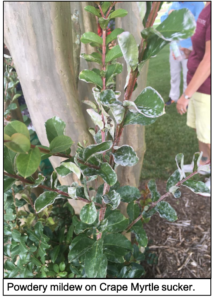Powdery Mildew on Crape Myrtle
go.ncsu.edu/readext?943204
en Español / em Português
El inglés es el idioma de control de esta página. En la medida en que haya algún conflicto entre la traducción al inglés y la traducción, el inglés prevalece.
Al hacer clic en el enlace de traducción se activa un servicio de traducción gratuito para convertir la página al español. Al igual que con cualquier traducción por Internet, la conversión no es sensible al contexto y puede que no traduzca el texto en su significado original. NC State Extension no garantiza la exactitud del texto traducido. Por favor, tenga en cuenta que algunas aplicaciones y/o servicios pueden no funcionar como se espera cuando se traducen.
Português
Inglês é o idioma de controle desta página. Na medida que haja algum conflito entre o texto original em Inglês e a tradução, o Inglês prevalece.
Ao clicar no link de tradução, um serviço gratuito de tradução será ativado para converter a página para o Português. Como em qualquer tradução pela internet, a conversão não é sensivel ao contexto e pode não ocorrer a tradução para o significado orginal. O serviço de Extensão da Carolina do Norte (NC State Extension) não garante a exatidão do texto traduzido. Por favor, observe que algumas funções ou serviços podem não funcionar como esperado após a tradução.
English
English is the controlling language of this page. To the extent there is any conflict between the English text and the translation, English controls.
Clicking on the translation link activates a free translation service to convert the page to Spanish. As with any Internet translation, the conversion is not context-sensitive and may not translate the text to its original meaning. NC State Extension does not guarantee the accuracy of the translated text. Please note that some applications and/or services may not function as expected when translated.
Collapse ▲Adapted from article written by Jessica Strickland, Extension Agent Wayne County, NC available at go.ncsu.edu/readext?942025.
It is not a surprise this time of year to see diseases show up on some of our popular landscape plants. Crape myrtles are known for being essentially trouble-free plants with little disease and few insect problems, but one problem that can occur is a disease called powdery mildew.
Powdery mildew is a disease which is common on many ornamental trees and shrubs, including crape myrtles. Powdery mildew is a powdery white to light gray-colored fungus that will grow on succulent stems, leaves, buds, and flowers. Young plants and new growth are usually more severely damaged than older plants, leaves, or branches. Flowers that are heavily infected may fail to open. Parts of the plant that are severely infected will usually look distorted and stunted.
Powdery mildew is a disease which is common on many ornamental trees and shrubs, including crape myrtles. Powdery mildew will also show up in shady, damp locations especially where plants are crowded and air circulation is poor. High humidity and rainy conditions are good environmental conditions for powdery mildew to occur. The good news is there is several control measures that can be followed in order to prevent and treat powdery mildew.
If you are getting ready to purchase a crape myrtle, you can immediately control powdery mildew by purchasing a resistant variety and avoid susceptible varieties. Some crape myrtle varieties will have good to excellent resistance to powdery mildew, while others will be very susceptible. This is short list of varieties that carry resistance and other that do not (taken from Clemson Extension Crape Myrtle Disease Note.
Resistant Varieties:
- The Lagerstroemia indicax fauriei hybrids developed at the U. S. National Arboretum in Washington, D. C. are resistant to powdery mildew.
- Varieties with very good resistance to powdery mildew and fairly good tolerance to Cercospora leaf spot include: ‘Apalachee,’ ‘Basham’s Party Pink,’ ‘Caddo,’ ‘Dodd #2’, ‘Fantasy,’ ‘Glendora White,’ ‘Hopi,’ ‘Lipan,’ ‘Miami,’ ‘Osage,’ ‘Pecos,’ ‘Regal Red,’ ‘Sarah’s Favorite,’ ‘Sioux,’ ‘Tonto,’ ‘Tuscarora,’ ‘Tuskegee,’ ‘Velma’s Royal Delight’, and ‘Wichita.’ ‘Apalachee’ and ‘Fantasy’ are totally resistant to powdery mildew.
- ‘Catawba,’ ‘Cherokee,’ ‘Seminole’, and ‘Yuma’ have some resistance to powdery mildew.
Varieties to Avoid:
- ‘Gray’s Red,’ ‘Orbin’s Adkins, ‘ ‘Carolina Beauty,’ ‘Wonderful White,’ ‘Raspberry Sundae’, and ‘Potomac.’
There are some cultural practices that will help reduce or prevent powdery mildew from occurring on crape myrtles. Be sure to remove sprouts (suckers) at the base of the plant as they occur. Since the sprouts are new growth, they are more susceptible to powdery mildew. Once these sprouts become infected, the fungus easily spreads to the upper portions of the plant. Planting crape myrtles in the proper location will also help discourage powdery mildew. Crape myrtles should be planted in a sunny location. Planting a crape myrtle in a shady location will not only encourage powdery mildew but shade will also reduce flowering. When pruning a crape myrtle, thin the canopy so that you allow good air circulation throughout the tree. Good air circulation will allow leaf surfaces to dry off quickly after a rain and reduce powdery mildew development. Pruning out severely diseased portions of the plant will also help reduce the disease if only a few parts are infected.
If the disease is severe enough, there are some chemical control options available. Fungicides that will control powdery mildew on crape myrtles and other ornamentals include: myclobutanil (Eagle, Immunox), triforine (Funginex), propiconazole (Banner Maxx), and triadimefon (Bayleton, Strike). When using fungicides remember to read the label and follow directions.
If you would like more information on Crape Myrtle and its disease, contact Daniel Simpson at 252-745-4121 or daniel_simpson@ncsu.edu.




